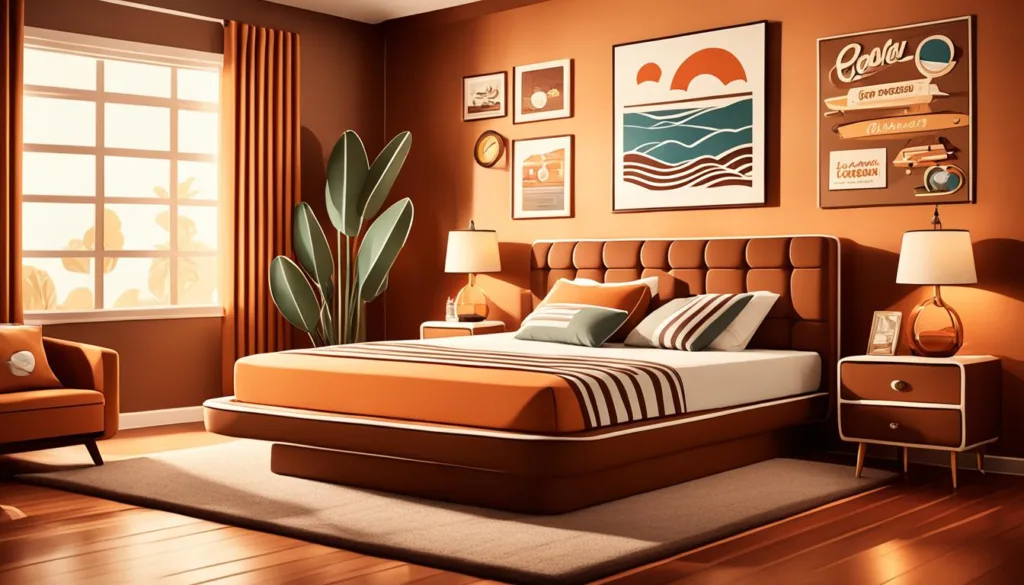Waterbeds in 1980s: Nostalgic Comfort Trend
Riding the Wave of Comfort: Exploring Waterbeds in the 1980s

Step into the past where waterbeds in 1980s made a splash in bedrooms across America. These nostalgic waterbed designs, an icon of relaxation and modernity, provided an unconventional sleep experience that mirrored the decade’s innovative spirit. With waterbeds claiming roughly 20% of the market, 1980s waterbed trends reflected a cultural shift that embraced luxury and the height of personalized comfort in sleep technology. However, despite their widespread allure, the rise of radical designs like memory foam began to redefine comfort and luxury in the bedroom, capturing the minds and bodies of consumers seeking state-of-the-art support and pressure relief.
Key Takeaways
- The 1980s saw the pinnacle of waterbed popularity, embedded deeply in the era’s quest for luxury and comfort.
- Nostalgic waterbed designs symbolized the blend of modernity and counterculture.
- 1980s waterbed trends provided a sleep experience that was both a statement piece and a comfort revolution.
- Despite their initial success, practical challenges led to a shift towards newer technologies like Tempur-Pedic memory foam.
- The mattress industry’s evolution during the ’80s set the stage for today’s diverse range of bedding options.
Waterbeds in 1980s: A Symbol of Rebellion and Relaxation
The 1980s was a decade of bold statements and personal expression, which resonated deeply through the History of Waterbeds. Nothing captured this zeitgeist better than the 1980s Waterbed Craze, with its iconic designs and the promise of a bespoke lifestyle. Innovator Charles Hall revolutionized sleep with his creation, making waterbeds emblematic of comfort and individuality. Against the norm of box-springs and firm mattresses, these Classic Waterbed Models offered a floating oasis that swiftly became a bedroom centerpiece for those looking to stand out from the crowd.
In your quest to understand why waterbeds became such a cultural phenomenon, one must consider their countercultural appeal. Thrusting the conventional mattress aside, a waterbed in the bedroom proclaimed nonconformity and the embrace of alternative living. Plunge into the time when owning a waterbed was akin to making a statement — you were not settling for the status quo, you were curating your sanctuary of relaxation.
Let’s unravel the appeal of waterbeds by looking closely at the models that made history:
| Model | Features | Impact |
|---|---|---|
| The Original Waterbed | Free-flowing water chamber, temperature control | Pioneering comfort technology, ignited waterbed trend |
| The Waveless | Fiber-filled chambers to reduce motion | Enhanced stability, addressed criticism of motion disturbance |
| The Bookcase Waterbed | Built-in headboard with shelves, mirrored aesthetic | Melded function and fashion, space-saving design |
| The Soft-Side Waterbed | Foam edges, looks like a traditional mattress | Brought waterbeds into the mainstream, offered versatility in bedding furniture |
These models were not just about novelty; they were a revolution in comfort and design that resonated across the United States. Take a journey through this transformative era and recognize how the waterbed was much more than a place to sleep — it was an emblem of freedom and a testament to the era’s spirit of innovation.
“Read also: Waterbeds For Sale“
The Evolution of Sleep: Memory Foam and the Decline of Waterbeds
Throughout the 1980s, sleep technology underwent a significant transformation with Tempur-Pedic at the forefront, their memory foam innovation rivaling the dominant retro waterbed styles. The classic waterbed models, adored for their novelty, began to lose their appeal as memory foam’s entry into the market reshaped consumer preferences for sleep comfort.
The Dawn of Tempur-Pedic: An Expensive Game Changer
Tempur-Pedic became synonymous with luxury as it introduced memory foam mattresses with the ability to conform to one’s body shape, offering unmatched pressure relief. Despite its high cost, the premium experience provided by this cutting-edge material set a new standard in sleeping solutions, edging classic waterbed models out of the spotlight.
Challenges of Waterbeds: Maintenance and Practicality
Retro waterbed styles, once the epitome of modern sleeping, began to confront challenges that compromised their practicality. High maintenance, the risk of leakage, and a laborious moving process made classic waterbed models less attractive compared to the convenience of new mattress technologies. Memory foam’s entry into the market presented a practical and user-friendly alternative that gradually usurped the waterbed’s place in bedrooms across America.

As we delve deeper into the juxtaposition of these two distinctive sleeping options, it’s evident that the pursuit of comfort and maintenance ease has considerably influenced consumer choices. The table below captures the contrasts between retro waterbed styles and the revolutionary Tempur-Pedic memory foam, highlighting the pros and cons that swayed the market:
| Feature | Classic Waterbed Models | Tempur-Pedic Memory Foam |
|---|---|---|
| Comfort | Body-contouring fluid support | Pressure-relieving foam conforms to body |
| Maintenance | Requires periodic water level adjustment and puncture repairs | Low maintenance with durable materials |
| Portability | Difficult to move once filled; often needs draining | Easier to transport, albeit heavy |
| Price Point | Generally affordable, but with added costs for accessories and maintenance | Higher initial cost but lower long-term maintenance |
| Longevity | Varies; susceptible to leaks and damage over time | Long-lasting with typically longer warranties |
In hindsight, the decline of waterbeds was an inevitable response to the market’s evolution, pivoting towards solutions that simplified upkeep without compromising comfort. While the allure of waterbeds remains for some, memory foam’s pragmatic allure has proved more enduring in the contest of sleep innovations.
“You may be interested in: Best Waterbeds 2023“
The Cultural Impact of Waterbeds in 1980s on Home Decor and Lifestyle
When you think of the 1980s waterbed trends, images of decadent lifestyles and personalized spaces instantly come to mind. The rise of waterbeds not only changed the way people slept but had a profound influence on interior design and personal expression within homes. These nostalgic waterbed designs were not just about comfort; they represented a revolution in the concept of private living spaces.
The waterbed became more than a piece of furniture—it was an expression of individuality and a beacon of the new era’s opulence. As time passed, the traditional double bed was replaced by the more grandiose king and queen-sized waterbeds, echoing the societal shift towards larger personal sanctuaries. This embracement of larger waterbeds mirrored the changes in society, where the bedroom transformed from a mere place of rest into a retreat reflecting one’s personal style and aspirations.
Let’s take a stroll through memory lane and explore how waterbeds reshaped home environments:
- King and Queen-Sized Dominance: Offering ample space, these waterbeds became a status symbol that touted luxury and cutting-edge living.
- Innovative Materials and Textures: Manufacturers experimented with various vinyl exteriors and plush, padded rails, diversifying visual and tactile aesthetics.
- The Avant-Garde Factor: Waterbed frames with elaborate bookshelves, mirrored canopies, and built-in audio systems added to the room’s overall ambiance.
- Thematic Designs: From faux wood finishes to velvet-covered frames, waterbeds were customizable to fit a range of decor themes.
In the heart of these design choices was the desire for a personal oasis—a space where the stresses of everyday life could be washed away beneath the gentle waves of a waterbed.
While today’s bedrooms may differ in style and substance, the impression left by the waterbed era endures. Denizens of contemporary design can draw inspiration from the creativity and sense of luxury that waterbeds brought into the home decor lexicon. To fully appreciate the impact of this trend, here’s an overview of the waterbed’s historical contribution to home interior styling:
| Year | Waterbed Innovation | Home Decor Impact |
|---|---|---|
| Early 1980s | Introduction of Plush, Padded Waterbed Rails | Softened Room Aesthetics and Added Comfort |
| Mid-1980s | Waterbeds with Bookshelves and Storage | Maximized Space Utility While Maintaining Style |
| Late 1980s | Canopied Waterbed Frames | Heightened the Sense of Drama and Luxury in Bedroom Designs |
The nostalgia of 1980s waterbed designs continues to evoke memories of an age rich with innovation and personalization, reminding us that the history of our living spaces is as fluid and evolving as the waterbeds once were.
“See: Gel Mattresses For Sale“
Marketing and Innovation: Waterbeds’ Role in the Mattress Industry
Reflecting on the remarkable surge in waterbeds’ popularity in the 1980s, we uncover how strategic branding in the mattress industry not only boosted sales figures but also changed the way people perceived sleep and comfort. Brands like Sealy and Serta, household names in bedding, understood that they were not merely selling mattresses; they were selling a promise of improved well-being and lifestyle enhancement.
Strategic Branding: Selling More Than Just a Mattress
During the decade, these companies carried out audacious marketing campaigns, connecting with consumers on a deeper level. They propagated the notion that a mattress was more than a sleeping surface—it was a tool for health and happiness. By highlighting features like comfort and innovation with waterbeds, they managed to position their products as must-haves in every modern home. As a direct result, strategic branding became a driving force behind the mattress industry’s growth spurt at the time.

Regulatory Standards: Enhancing Safety and Assurance
While marketing strategies propelled the waterbed to stardom, another significant move was taking place in the background. The U.S. Consumer Product Safety Commission was laying down flammability standards for mattresses, including waterbeds, starting in 1987. These new regulations did more than just set safety benchmarks; they gave consumers confidence and peace of mind. Compliance with these standards communicated a company’s commitment to quality and care, further influencing the purchase decisions of the discerning buyer.
The strategic branding efforts, coupled with regulatory advancements, charted a course for the waterbed to become an iconic symbol of the 1980s. Chronologically distant yet memorable, the story of waterbeds in the mattress industry is not solely about products but also about the power of marketing and the importance of consumer safety in the equation of success.
“Read also: Airbeds Stretch Features“
Retro Waterbed Styles vs. Contemporary Bedding Solutions
As you explore the world of bedroom furniture, the comparison between retro waterbed styles and contemporary bedding solutions becomes increasingly compelling. The waterbeds’ popularity in the 1980s reflected a unique cultural fascination that integrated innovation with personal style. However, the passage of time has seen these once-beloved beds become more of a niche artifact than a mainstream selection.
Contemporary bedding solutions boast advancements in technology and design, offering practical and customizable options that cater to diverse preferences. From memory foam’s pressure-relieving comfort to hybrid mattresses combining coils and foam for optimal support, the choices are vast. Unlike the cumbersome and high-maintenance waterbeds, modern beds embody an evolution toward convenience and adaptability without sacrificing the plush comfort that consumers desire.
- Memory foam mattresses that contour precisely to your body.
- Hybrid models that provide the bounce of springs with the soft comfort of foam layers.
- Adjustable beds that allow customizable sleep positions and firmness levels.
While waterbeds may have offered a trendy and unique sleep experience, their practical drawbacks and the superior features of modern mattresses have led many to adopt more contemporary bedding solutions. For those who still cherish the wave-like sensation and the distinct aesthetic of waterbeds, their appeal endures as a testament to the era’s inventive spirit.
“You may be interested in: Gel Mattresses Reviews“
Conclusion
The 1980s heralded a major shift within the mattress industry, marking the era when the allure of waterbeds peaked as both a nostalgic comfort trend and a statement of individuality. The history of waterbeds is not merely a tale of a product’s rise and fall, but a reflection of consumer behavior and the perpetual pursuit of personalized comfort. The waterbed’s journey from being a sought-after sleep innovation to becoming a receding but cherished memory demonstrates the dynamic nature of market trends and lifestyle choices.
In the epoch of waterbeds in 1980s, they embodied a combination of luxury and defiance, promising not just a place to rest but also an expressive living statement. As the industry evolved, however, the focus shifted toward revolutionary materials like memory foam, which addressed practical needs and reshaped consumer expectations. Yet, the distinctive waterbed still holds a fond place in the hearts of many, as a symbol of an era when comfort merged with audacious design.
Your own memory of the 1980s may resonate with the distinct sensation of a waterbed’s gentle motion, or perhaps this iconic piece of furniture before your time sparks curiosity. Its diminished visibility in today’s market does not erase its potent legacy, nor does it quell the possibility of a resurgence. As trends oscillate and the quest for the perfect night’s sleep continues, the concept of the waterbed remains afloat in the vast sea of bedding solutions, reminding us that the currents of innovation are as whimsical as they are relentless.
FAQ
What made waterbeds so popular in the 1980s?
Waterbeds gained popularity in the 1980s as they were seen as symbols of modernity, rebellion, and relaxation. They appealed to individualism and offered a unique comfort through their innovative design, aligning with the era’s taste for personal home decor and luxury.
Who invented the waterbed, and how did it impact the 1980s?
Charles Hall is credited with inventing the modern waterbed as part of a master’s degree project in the late 1960s. His design gained massive popularity in the 1980s, symbolizing a countercultural and comfortable alternative to traditional mattresses.
What led to the decline of waterbeds after their peak in the 1980s?
Waterbeds began to decline in popularity due to their practical challenges such as weight, difficulty in moving, and the potential for leaks. Additionally, advancements in mattress technology, such as the introduction of memory foam, provided consumers with more convenient and low-maintenance options.
How did the introduction of memory foam change the mattress industry in the 1980s?
Memory foam, introduced by Tempur-Pedic, revolutionized the mattress industry by offering new levels of comfort and support through its ability to contour to the body. Although initially expensive, it set a new standard for mattress technology and became a serious competitor to traditional mattresses, including waterbeds.
How did waterbeds influence home decor and lifestyle in the 1980s?
In the 1980s, waterbeds influenced home decor by becoming a statement piece in the bedroom, reflecting a desire for both aesthetic appeal and individual expression. They were often associated with luxury and contributed to the concept of the bedroom as a personal sanctuary or retreat.
What marketing strategies did waterbed companies employ during their peak popularity?
During their peak, waterbed companies utilized aggressive marketing campaigns that highlighted the uniqueness, comfort, and modern appeal of waterbeds. These strategies capitalized on the zeitgeist, promoting both a lifestyle and a product that exemplified personal luxury and innovation.
What regulatory standards affected the mattress industry in the 1980s?
The U.S. Consumer Product Safety Commission introduced mattress flammability standards in 1987 to ensure consumer safety and assurance. These standards were designed to reduce the risks associated with mattress fires, ultimately enhancing the safety of all mattress products on the market.
Are waterbeds still available today, and how do they compare to modern mattresses?
Waterbeds are still produced and available today, but they are considered a niche product. They exist alongside a wide variety of contemporary mattresses and bedding solutions. While they offer a unique sleeping experience, they often do not match the convenience and low maintenance of newer mattress technologies.
Could waterbeds experience a resurgence in popularity?
There is potential for a nostalgic resurgence of waterbeds, given the cyclical nature of consumer trends and the ongoing interest in retro styles. However, their return to mainstream popularity would likely depend on modern innovations that address their former practical challenges.

